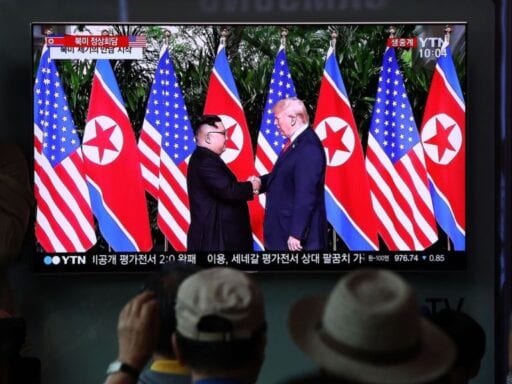Here are three scenarios of how it could play out.
After their first and only meeting last year, President Donald Trump said he and North Korean leader Kim Jong Un “fell in love.” Now they’ve agreed to a second date in hopes of taking the relationship to the next level.
White House Press Secretary Sarah Sanders said on Friday afternoon that Trump will meet Kim toward the end of February at a location to be named later.
The announcement came after Kim Yong Chol, a top North Korean official, arrived in Washington on Thursday night to finalize plans for the summit between his boss and Trump, people familiar with the discussions told me.
Kim met Friday morning with Secretary of State Mike Pompeo — who has taken the lead role in negotiating with North Korea — and reportedly brought a handwritten letter from the North Korean leader for the president. They then went to the White House for an early afternoon meeting in the Oval Office that lasted about 90 minutes.
Pompeo and Kim Yong Chol are now in a lunch to continue discuss, according to the State Department.
The second-summit decision is controversial: The US and North Korea have made very little progress in negotiating an end to Pyongyang’s nuclear program since the two leaders met in Singapore last June — and experts warn this meeting may not break the logjam while giving Kim another opportunity to look like a statesman on the world stage.
Working-level talks between the two sides have stalled, US officials say, and the two sides are basically at an impasse: America is demanding that North Korea offer a full, detailed list of its nuclear inventory before the US lifts any sanctions on the country, and Pyongyang is demanding the sanctions be lifted before it offers the full list and seriously begins to downgrade its nuclear capabilities.
That means it’s now up to Trump to make headway with Kim, who so far has shown no signs of relenting. In fact, North Korea has actually continued to improve its nuclear and missile programs since the two men met.
But if the summit goes badly — or is canceled before it happens — it’s possible the diplomatic opening created in Singapore could close for good. At that point, there is a legitimate danger that both countries could revert to threatening each other with nuclear strikes again.
And that would be a much worse situation than the one we have now.
What will happen at the second Trump-Kim summit?
Vipin Narang, an expert on North Korea’s nuclear program at MIT, laid out three possible scenarios for what could happen at the next Trump-Kim meeting.
The first and best scenario is that Kim agrees to actually slow down his nuclear development and give up some of his arsenal. He could ship some of his intercontinental ballistic missiles out of his country, freeze plutonium and uranium production, and/or allow rigorous inspections of its key nuclear and missile facilities.
For that to work, though, the US would have to give up something considerable. One possible option is forever suspending large-scale military exercises with South Korea, events that Pyongyang considers preparations for war.
“This would be great,” Narang says. “Both sides could achieve something meaningful without losing face” and allow the leaders to build more trust between them.
However, there are no signs yet that a deal like that is in the works, especially since the US insists North Korea hand over a full list of its nuclear and missile assets — something Pyongyang doesn’t want to do because it could potentially help America target those sites during a war.
The second-best scenario is that the meeting is basically a carbon copy of the Singapore summit: Both leaders leave without having made any progress on striking a deal but agree to continue negotiating.
Kim could promise to continue the moratorium on rocket tests, which is something Trump would almost certainly accept as a win. “If Trump takes the bait,” says Andrea Berger, a nuclear expert at Middlebury Institute of International Studies, it will “further the fiction that there has been genuine progress in halting or reversing North Korean nuclear capabilities.”
That wouldn’t solve the nuclear issue, but it also wouldn’t make anything worse. As long as neither angers the other, the diplomatic process would likely continue.
The third scenario is the scariest: a failed summit.
That could come about in two ways. First, Trump or Kim, citing a lack of progress in the nuclear talks, could decide to cancel the summit beforehand. Trump actually did that just weeks before the 2018 Singapore summit, only to reverse course a little later.
But a for-real canceled event would be a major sign that at least one side has reached a breaking point and the diplomatic niceties might soon come to an end.
The other way the summit could fail is if the two meet and one of them ends up angering the other (or they both get pissed off) and they walk away from the negotiations altogether. That would be the worst outcome and would likely cause irreparable damage.
That wouldn’t necessarily mean that the two countries would immediately return to openly threatening each other, but it would certainly bring both countries back on the path of war.
So in just over a month, we will see if US-North Korea relations somehow get much better, stay roughly the same, or suddenly become a lot worse — and it’s all down to Trump’s dealmaking prowess.
Author: Alex Ward
Read More



